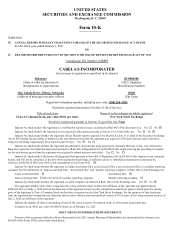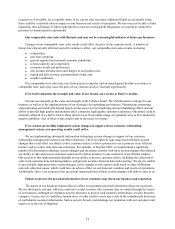Cabela's 2010 Annual Report Download - page 20
Download and view the complete annual report
Please find page 20 of the 2010 Cabela's annual report below. You can navigate through the pages in the report by either clicking on the pages listed below, or by using the keyword search tool below to find specific information within the annual report.10
Seasonality
We experience seasonal fluctuations in our revenue and operating results. Due to buying patterns around the
holidays and the opening of hunting seasons, our merchandise revenue is traditionally higher in the third and fourth
quarters than in the first and second quarters, and we typically earn a disproportionate share of our operating
income in the fourth quarter. Because of our retail store expansion, and fixed costs associated with retail stores, our
quarterly operating income may be further impacted by these seasonal fluctuations. We anticipate our sales will
continue to be seasonal in nature. Refer to Note 26 to our consolidated financial statements for quarterly results of
operations for 2010 and 2009.
Government Regulation
Regulation of World’s Foremost Bank. WFB, our wholly-owned bank subsidiary, is a Nebraska state-
chartered bank with deposits insured by the Bank Insurance Fund of the Federal Deposit Insurance Corporation
(“FDIC”). WFB is subject to comprehensive regulation and periodic examination by the Nebraska Department
of Banking and Finance (“NDBF”) and the FDIC. WFB does not qualify as a “bank” under the Bank Holding
Company Act of 1956, as amended (“BHCA”), because it is in compliance with a credit card bank exception from
the BHCA. On July 21, 2010, the Reform Act was signed into law. The Reform Act makes extensive changes to
the laws regulating financial services firms and credit rating agencies and requires significant rule-making. In
addition, the legislation mandates multiple studies which could result in additional legislative or regulatory action.
The Reform Act does not eliminate the exception from the definition of “bank” under the BHCA for credit card
banks, such as WFB. However, the Reform Act directs the Comptroller General of the United States to complete a
study within 18 months of the Reform Act’s enactment to determine whether it is necessary, in order to strengthen
the safety and soundness of institutions or the stability of the financial system, to eliminate certain exceptions
under the BHCA, including the exception for credit card banks. If the credit card bank exception were eliminated
or modified, we may be required to divest our ownership of WFB unless we were willing and able to become
a bank holding company under the BHCA. Any such forced divestiture would materially adversely affect our
business and results of operations. In addition, the Reform Act establishes a new independent Consumer Financial
Protection Bureau (the “Bureau”) which will have broad rulemaking, supervisory, and enforcement authority over
consumer products, including credit cards. The Reform Act will also effect a number of significant changes relating
to asset-backed securities, including additional oversight and regulation of credit rating agencies and additional
reporting and disclosure requirements. See “Risk Factors - The Dodd-Frank Wall Street Reform and Consumer
Protection Act may impact the practices of our Financial Services business and could have a material adverse effect
on our results of operations” and “Management’s Discussion and Analysis of Financial Condition and Results of
Operations - Developments in Legislation and Regulation.”
There are various federal and Nebraska laws and regulations relating to minimum regulatory capital
requirements and requirements concerning the payment of dividends from net profits or surplus, restrictions
governing transactions between an insured depository institution and its affiliates, and general federal and
Nebraska regulatory oversight to prevent unsafe or unsound practices. At the end of 2010, WFB met the
requirements for a well-capitalized institution, the highest of the Federal Deposit Insurance Corporation
Improvement Act’s five capital ratio levels. A well-capitalized classification should not necessarily be viewed as
describing the condition or future prospects of a depository institution, including WFB.
At the beginning of 2010, WFB’s required capital was increased under regulatory capital requirements of the
applicable federal agencies as a result of new accounting standards which required the consolidation of the assets
and liabilities of the Cabela’s Master Credit Card Trust and related entities (collectively referred to as the “Trust”)
on WFB’s balance sheet. As of December 31, 2010, the most recent notification from the FDIC categorized WFB
as well-capitalized under the regulatory framework for prompt corrective action. In order for WFB to continue to
meet the minimum requirements for the well-capitalized classification under the regulatory framework for prompt
corrective action, we invested $150 million in 2010 in additional capital in WFB. See “Risk Factors - We may
have to reallocate capital from our Retail and Direct businesses to meet the capital needs of our Financial Services
business, which could alter our retail store expansion program” and “Management’s Discussion and Analysis of
Financial Condition and Results of Operations - Impact of New Accounting Pronouncements.”
























